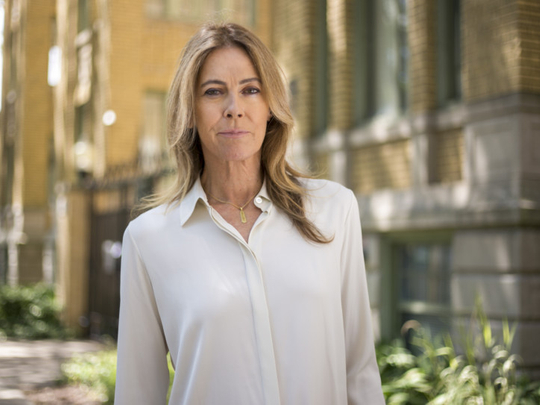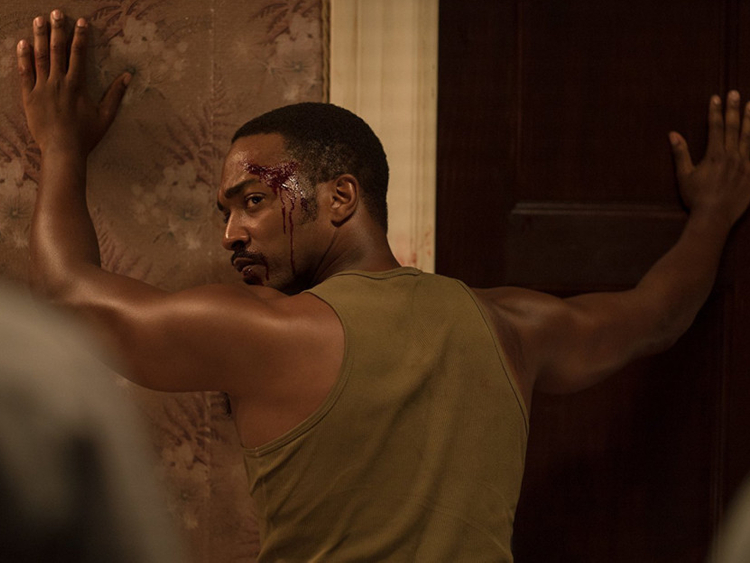
They crept through this city clutching their rifles, an army of jittery cops and National Guardsmen surrounded by an armoured battalion that seemed more suitable for a Vietnam jungle than a Middle American thoroughfare. But this was war, the early days of an uprising by black Detroiters. And so the mostly white law enforcement regime rolling through the cauldron of smoke and rubble was determined to restore order by any means necessary.
This meant that when a little girl peeked through the blinds of an apartment to see what was going on, the grim outcome was inevitable.
“Sniper in the window!” a guardsman yelled almost as quickly as he fired shots that all but obliterated the window.
The camera moves on from the smoky aftermath of this jarring moment in director Kathryn Bigelow’s latest feature film, Detroit. What lingers, however, is the sense of racial terror that pulsed through this city in 1967 during one of the United States’ most infamous episodes of civil unrest.
Bigelow, director of Zero Dark Thirty, is in her sweet spot when transforming real life into high art. But with Detroit, she had to wrestle with how far to push reality — how to convey the real-life horror of racism, without exploiting black trauma. “It’s really a question of how do you humanise and how do you bring to life a situation,” Bigelow said. “I suppose you use a personal judgment, I guess.”
Bigelow’s nonfictional judgment has earned her scorn in the past — most notably criticism that she gave false, misleading credit to the role that torture played in capturing Osama bin Laden.
Now with Detroit, this Oscar-winning filmmaker could be facing her most ambitious, and contentious, project to date. She is a white woman from Northern California telling a story of the black experience in civil rights era Detroit, which Bigelow said was not lost on her. It certainly was not lost on her cybercritics, who from the start were quick to wield billy clubs full of scepticism over whether she had erased the role of black women during the unrest in Detroit or had the cultural pedigree to convey a story of black oppression.
- Mark Boal, Screenwriter
The movie focuses on a little-known horror amid the five-day riot (locals argue that “rebellion” is a more accurate term) that left 43 dead, nearly 1,200 injured and the city scarred. On the third night of the unrest, police stormed the Algiers Motel, where they suspected a sniper had been firing at them. Officers terrorised several black teenage boys and two white women who had been staying there, a macabre episode that ended with the deaths of three of the boys and the acquittal of the officers. How’s that for reality?
Bigelow received the story from screenwriter Mark Boal at a time when its power, importance and necessity could not be ignored: A grand jury had just declined to indict a white police officer in the killing of Michael Brown, an unarmed African-American teenager, in Ferguson, Missouri, in 2014.
“It was two things simultaneously,” Bigelow, 65, said of her initial reaction. “One is kind of a, ‘I’m white, am I the right person to do it?’ And the other is an extremely emotional reaction to the constant recurring of these events.”
She realised, she added, “that I have this opportunity to expose this story in the hope that maybe it either generates a conversation, begins to generate a conversation and/or encourages more stories like this to come forward. To do nothing was not an answer.”
A time of heightened scrutiny
If the time is right for this movie, it is also daring. Detroiters, coming out of the nation’s largest municipal bankruptcy, are touchy over how their city’s narratives are told, whether it be the jaded tales of blight or the glowing renaissance stories that somehow overlook those in the black majority being left behind. And more broadly, we are in a moment of heightened scrutiny over how black Americans are treated by police and how they are portrayed in films, books and news coverage.
The reality of two Americas means that there is a significant segment of the population for whom the idea of racism in policing is either difficult to grasp or fiction. That makes the telling of this story by someone like Bigelow vitally important, said Michael Eric Dyson, the scholar and activist. Her broad appeal can attract white viewers who might not otherwise go to see a movie about this topic, he said.
“This is a white woman telling the truth as much as she can on film about racial injustice in America,” said Dyson, a Detroit native whom Bigelow consulted on the movie. “That will resonate very powerfully with white folks. What better way to use your white privilege than to undermine it, raise questions about it, leverage it on behalf of black and brown people who usually don’t have a voice in the matter at all.” Being true and authentic to the story, Bigelow said, meant relying on a concept she took from Boal, who is also white, when they first worked together on The Hurt Locker in 2009: film as journalism.
- Kathryn Bigelow, Director
For Bigelow, creating Detroit involved practicing the discretion that journalists grapple with after police killings. Is that video of the young man bleeding out behind the steering wheel of his car too gruesome to air? What about the footage of the man being gunned down from behind as he runs from a police officer? Do we examine a victim’s criminal record, or an officer’s misconduct record?
These can be perilous tasks, as I learned the hard way when, in an effort to humanise Brown after he was killed in Ferguson, my description of him as “no angel” in an article overshadowed the sympathetic elements of his life.
Bigelow also found herself engaging in another basic journalistic practice: immersing herself in unfamiliar lives and experiences, and trying to make sense of them.
Without the rights to John Hersey’s book, The Algiers Motel Incident — his estate would not sell them — Boal and Bigelow based their story on extensive research. They studied contemporaneous news accounts and court records and interviewed people who were in and around the Algiers at the time. Boal said he was particularly moved by Larry Reed, a singer with a group called the Dramatics, who was in the motel during the incident and whose life was upended by it, and Melvin Dismukes, a black private security guard who had entered the motel with police and broke down in tears when he recounted the events to Boal.
“As a dramatist, I was interested in the struggle to survive that night and also to sort of, to piece an identity back together after that kind of trauma,” Boal said, adding that he consulted with black historians and scholars to maintain the authenticity and integrity of the story. “All I can do is try to be respectful and humble and recognise my shortcomings, and, by the same token, use whatever influence I might have in Hollywood to do things that I think are meaningful.”
Black women missing?
Although the filmmakers insist that they stuck to historical facts in constructing Detroit, they did have to sprinkle Hollywood dust on parts of the story because some details of what happened remain murky.
Some have criticised the absence of fully realised black women in the movie. (Jetmag.com asked of the movie’s trailer, “Why are black women missing”?) Others have questioned the depth of its characters and its effectiveness as a political tool. Charles Ezra Ferrell, vice president for public programmes at the Charles H. Wright Museum of African American History in Detroit, said he wished the unrest had been placed in better context.
“There had been a long trail of police violence against the black community prior to ’67,” he said. “They don’t even tell the history correctly in the beginning. So, therefore, if you don’t have a foundation of what caused that event, you see these as looters. That undermines the story significantly.”
But Ferrell and others praised Bigelow’s ability to make the raw, racist brutality inflicted upon black bodies up close and personal.
As someone who choked on tear gas while covering protests in Ferguson, I found it easy to appreciate the us-against-them divide that the film depicts between police and black people. In one scene, officers in riot gear initially rebuff Fred Temple (played by Jacob Latimore) when he tries to get past them to go to work. I could not help but think of the night in Ferguson when a line of police officers, trying to clear the streets, marched towards me and ordered me to go home, even though news media were allowed to stay. I had a press pass dangling from my neck, but I guess that did not matter to them when the person wearing it was a black man with dreadlocks.
To draw her actors into the chaotic moments from half a century ago, Bigelow withheld parts of the script from some until the last moment. That kept them guessing on important points, like who would die in the motel, which helped elicit real emotion and fear.
“We know how good of a storyteller Kathryn is,” said Algee Smith, who is from nearby Saginaw and plays Reed. “We see that she holds no punches in the way that she tells a story. She makes you feel like you’re in there. With this, the story has to be told in a certain way for people to connect. So it’s not about what colour the person is shooting the film. It’s about who can tell the story the best.”
A day before the film’s world premiere here, Bigelow sat comfortably in a room in a downtown fire station turned boutique hotel, where the elevator walls are upholstered with caramel leather. It was a stark contrast to the boarded up swaths of Detroit, just minutes away, still suffering the effects of the 1967 unrest.
Bigelow makes no bones about the fact that she was an outsider trying to tell a story touching on some of the roots of Detroit’s pain. From the all-too-expected outcome of the trial of the police officers accused of the Algiers killings, to the way the officers concocted stories to justify the shootings, when the focus is not on who made the film, it is striking to see how the picture lives in the present day.
“As far as for the policemen now, I really don’t even think it’s too much different,” Dismukes said. “They handle themselves a little different because now, a whole lot of them got the body cams and stuff like that. But you still have your few violent policemen out there that just don’t give a rip about your rights.”
It’s on lessons like that where Bigelow, who says she’s more comfortable behind the camera than in front of it, wants the focus.
“If you don’t face the sort of, the travesties that are constantly recurring in this culture,” she said, “how are they ever going to change?”
___
Don’t miss it
Detroit releases in the UAE on January 11.













